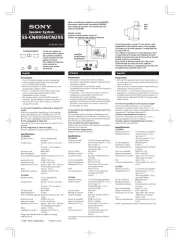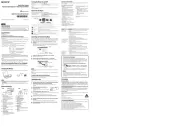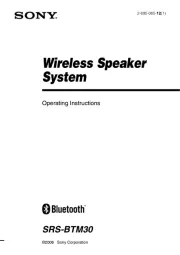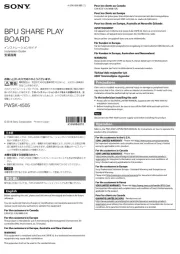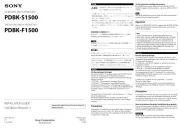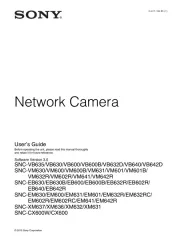
To reduce the risk of fire, do not cover the ventilation
opening of the apparatus with newspapers, tablecloths,
curtains, etc. Do not place the naked flame sources such
as lighted candles on the apparatus.
To reduce the risk of fire or electric shock, do not expose
this apparatus to dripping or splashing, and do not place
objects filled with liquids, such as vases, on the apparatus.
Do not install the appliance in a confined space, such as a
bookcase or built-in cabinet.
As the main plug of AC adaptor is used to disconnect
the AC adaptor from the mains, connect it to an easily
accessible AC outlet. Should you notice an abnormality
in it, disconnect it from the AC outlet immediately.
Do not expose batteries or apparatus with battery-
installed to excessive heat such as sunshine, fire or the
The AC adaptor is not disconnected from the mains as
long as it is connected to the AC outlet, even if the main
unit itself has been turned off.
The nameplate is located on the bottom exterior of the
main unit and on the surface of the AC adaptor.
The use of optical instruments with this product will
This appliance is classified
exterior of the main unit.
Notice for customers: the following
information is only applicable to
equipment sold in countries applying EU
This product has been manufactured by or on behalf
of Sony Corporation, 1-7-1 Konan Minato-ku Tokyo,
108-0075 Japan. Inquiries related to product compliance
based on European Union legislation shall be addressed
to the authorized representative, Sony Deutschland
GmbH, Hedelfinger Strasse 61, 70327 Stuttgart,
Germany. For any service or guarantee matters, please
refer to the addresses provided in the separate service or
Disposal of Old Electrical &
(Applicable in the European
This symbol on the product or on its packaging indicates
that this product shall not be treated as household
waste. Instead it shall be handed over to the applicable
collection point for the recycling of electrical and
electronic equipment. By ensuring this product is
disposed of correctly, you will help prevent potential
negative consequences for the environment and human
health, which could otherwise be caused by inappropriate
waste handling of this product. The recycling of materials
will help to conserve natural resources. For more detailed
information about recycling of this product, please
contact your local Civic Office, your household waste
disposal service or the shop where you purchased the
Applicable accessory: Remote commander
Disposal of waste batteries
(applicable in the European
This symbol on the battery or on the packaging indicates
that the battery provided with this product shall not be
treated as household waste.
On certain batteries this symbol might be used in
combination with a chemical symbol. The chemical
symbols for mercury (Hg) or lead (Pb) are added if the
battery contains more than 0.0005% mercury or 0.004%
By ensuring these batteries are disposed of correctly,
you will help prevent potentially negative consequences
for the environment and human health which could
otherwise be caused by inappropriate waste handling of
the battery. The recycling of the materials will help to
conserve natural resources.
In case of products that for safety, performance or data
integrity reasons require a permanent connection with an
incorporated battery, this battery should be replaced by
qualified service staff only. To ensure that the battery will
be treated properly, hand over the product at end-of-life
to the applicable collection point for the recycling of
electrical and electronic equipment.
For all other batteries, please view the section on how
to remove the battery from the product safely. Hand the
battery over to the applicable collection point for the
recycling of waste batteries.
For more detailed information about recycling of this
product or battery, please contact your local Civic Office,
your household waste disposal service or the shop where
you purchased the product.
A DualDisc is a two sided disc product which mates
DVD recorded material on one side with digital
audio material on the other side. However, since the
audio material side does not conform to the Compact
Disc (CD) standard, playback on this product is not
Music discs encoded with copyright
This product is designed to playback discs that conform
to the Compact Disc (CD) standard. Recently, various
music discs encoded with copyright protection
technologies are marketed by some record companies.
Please be aware that among those discs, there are some
that do not conform to the CD standard and may not be
playable by this product.
License and Trademark Notice
MPEG Layer-3 audio coding technology and patents
licensed from Fraunhofer IIS and Thomson.
Windows Media is either a registered trademark or
trademark of Microsoft Corporation in the United
States and/or other countries.
This product is protected by certain intellectual
property rights of Microsoft Corporation. Use or
distribution of such technology outside of this product
is prohibited without a license from Microsoft or an
authorized Microsoft subsidiary.
All other trademarks and registered trademarks are of
their respective holders. In this manual,
to select the clock set mode.
If “PLAY SET” flashes, press /
select “CLOCK,” and then press (enter)
repeatedly to set the hour, then press
4 Use the same procedure to set the minutes.
The clock settings are reset when you disconnect the power cord or if
To display the clock when the system is off
. The clock is displayed for about
1 Select the CD function.
Push the center part of the disc with two fingers until
the disc snaps into its mounted position.
on the unit and remove the
disc by pulling up the edge of the disc while holding one
finger against the spindle.
The system will automatically close the CD door if a few minutes
elapse of no operation with the CD door open.
Do not set a disc with non-standard shapes (e.g., heart, square, star).
The disc may fall into the system and cause irreparable damage.
with the CD door open, the system will
automatically close the CD door.
Do not use a disc with tape, seals or paste on it as this may cause a
When you eject a disc, handle the disc by its edge. Do not touch the
resume play, press the button again.
playback, and release the button at
repeatedly while the player is
stopped. You can select Normal Play mode (“Normal”
or “FLDR” for all MP3 files in the folder on the disc),
Shuffle Play mode (“SHUF” or “FLDR SHUF*” for folder
shuffle), or Program Play mode (“PGM”).
* When playing a CD-DA (audio) disc, FLDR (SHUF) Play performs
the same operation as normal (SHUF) Play.
“ ” indicates that all tracks or files will be repeated until you stop
“ 1” indicates that a single track or file will be repeated until you
Notes on Shuffle Play mode
When Shuffle Play mode is set to “SHUF,” the system shuffle-plays
all tracks or files on the disc. When Shuffle Play mode is set to
“FLDR SHUF,” the system shuffle-plays all tracks or files in selected
When you turn off the system, the selected Shuffle Play mode
(“SHUF” or “FLDR SHUF”) is cleared and the play mode returns to
Normal Play mode (“FLDR”).
Notes on playing MP3 discs
Do not save other types of tracks or files, or unnecessary folders on a
Folders that have no MP3 files are skipped.
The system can only play MP3 files that have a file extension of
Even when file name has the “.mp3” file extension, if the actual
file differs, playing this file may generate a loud noise which could
damage the system may malfunction.
255* folders (including the root folder)
512 MP3 files in a single folder
9 folder levels (in the tree structure of files)
1 Connect the AC adaptor to the unit.
2 Plug the AC adaptor into a wall outlet.
Connect an external audio component.
Compatibility with all MP3 encoding/writing software, recording
device, and recording media cannot be guaranteed. Incompatible
MP3 discs may produce noise or interrupted audio or may not play
* This include folders that have no MP3 or other files. The number
of folders that the system can recognize may be less than actual
number of folders, depending on the folder structure.
Creating your own program
1 Select the CD function.
appears while the player is stopped.
3 Select a folder (MP3 disc only).
repeatedly to select the desired
4 Select the desired track or file number.
repeatedly until the desired track
Total playing time for all the programmed tracks or
files, including the selected track or file, is displayed at
5 Program the selected track or file.
to enter the selected track or file.
“--.--” appears when the total playing time exceeds
100 minutes for an CD or when you program MP3
6 Repeat steps 3 through 5 to program additional
tracks or files, up to a total of 25 tracks or files.
7 To play your program of tracks or files, press
The program remains available until you remove the
disc from the disc compartment or unplug the
To play the same program again, press
disappears while the player is stopped.
To delete the last track or file of the program
while the player is stopped.
1 Select the TUNER function.
Press TUNER FM/AM FUNCTION
repeatedly or press FUNCTION
appears, and then press +/
automatically when a station is tuned in, and
“TUNED” and “STEREO” (for stereo programs only)
If “TUNED” does not light up and the scanning does
to stop scanning, then perform
When you tune in a station that provides RDS
services, information such as the service name or
station name is provided by broadcasts.
“MANUAL” appears, and then press +/
repeatedly to tune in the desired station.
To reduce static noise on a weak FM stereo station, press FM MODE
repeatedly until “MONO” appears to turn off stereo reception.
Presetting radio stations
1 Tune in the desired station.
the desired preset number.
If another station is already assigned to the selected
preset number, the station is replaced by the new
5 Repeat steps 1 through 4 to register other stations.
You can preset up to 20 FM and 10 AM stations.
FM lead antenna (Extend it horizontally.)
When the system is powered up, the setting status appears on the display panel.
When the system goes to Standby mode, the setting status disappears from the display panel.
Lights in amber when a signal is received from the remote.
This manual mainly explains operations using the
remote, but the same operations can also be performed
using the buttons on the unit having the same or similar
Remove the battery compartment lid, and insert the two
supplied R6 (size AA) batteries, side first, matching
the polarities shown below.
Notes on using the remote
With normal use, the batteries should last for about 6 months.
Do not mix an old battery with a new one or mix different types of
If you do not use the remote for a long period of time, remove the
batteries to avoid damage from battery leakage and corrosion.
Find a location and an orientation that provide good
reception, and then set up the AM antenna.
Keep the antenna away from the power cord to avoid
To tune in to a preset radio station
If you registered a radio station to a preset number 1
to 6, the radio station will be tuned in by just pressing
the TUNER MEMORY NUMBER (1 to 6) when the
system function is set to AM or FM.
If you registered a radio station to a preset number 7
or higher, press TUNING MODE repeatedly until
“PRESET” appears then press +/ repeatedly to
select the desired preset number.
Playing a file of the USB device
The audio format that can be played back on this system
* Files with DRM (Digital Rights Management) copyright protection
or files downloaded from an online music store cannot be played
on this system. If you try to play one of these files, the system plays
the next unprotected audio file.
Check the websites below for the information about
For customers in Europe and Russia:
<http://support.sony-europe.com/>
For customers in Latin America:
<http://www.sony-latin.com/index.crp>
For customers in Asia and other countries/regions:
<http://www.sony-asia.com/support>
1 Select the USB function.
2 Connect the USB device to the (USB) port
resume play, press the button again.
. To resume play, press
cancel resume play, press
during playback, and release the
button at the desired point.
When playing a VBR MP3/WMA file, the system may resume
playback from a different point.
Resume play returns to the top folder.
repeatedly while the player is
stopped. You can select Normal Play mode (playback
in sequence of all files on the USB device), Folder
Play mode (“FLDR” for all files in the specified folder
on the USB device), Shuffle Play mode (“SHUF” or
“FLDR SHUF” for folder shuffle), or Program Play mode
When you turn off the system, the selected Shuffle Play mode
(“SHUF”) is cleared and the play mode returns to Normal Play mode.
Notes on Shuffle Play mode
When Shuffle Play mode is set to “SHUF,” the system shuffle-plays
all audio files on the USB device. When Shuffle Play mode is set to
“FLDR SHUF,” the system shuffle-plays all audio files in selected
When you turn off the system, the selected Shuffle Play mode
(“SHUF” or “FLDR SHUF”) is cleared and the play mode returns to
Normal Play mode (“FLDR”).
If you select “ ” when the system is in Normal Play mode, the
system executes repeat play of all audio files in the USB device until
you stop playback. If you select “ ” when the system is in Folder
Play mode, the system executes repeat play of all audio files in the
selected folder until you stop playback.
If you select “ 1,” the system executes continuous repeat play of
the selected file until you stop playback.
The playback order for the system may differ from the playback
order of the connected digital music player.
Be sure to turn off the system before removing the USB device.
Removing the USB device while the system is turned on may corrupt
the data on the USB device.
When USB cable connection is necessary, connect the USB cable
supplied with the USB device to be connected. See the operation
manual supplied with the USB device to be connected for details on
It may take time before “READING” appears, depending on the type
The system does not support a USB hub. Do not connect the USB
device through a USB hub.
When the USB device is inserted, the system reads all the files on the
USB device. If there are many folders or files on the USB device, it
may take a long time to finish reading the USB device.
With some connected USB devices, after an operation is performed,
there may be a delay before it is performed by this system.
Compatibility with all encoding/writing software cannot be
guaranteed. If audio files on the USB device were originally encoded
with incompatible software, those files may produce noise or
interrupted sound, or may not be played back at all.
This system cannot play audio files on the USB device in the
when the total number of audio files in a folder exceeds 999
when the total number of audio files on a USB device exceeds
when the total number of folders on a USB device exceeds 1000
(including the “ROOT” folder and empty folders)
These numbers may vary depending on the file and folder structure.
Do not save other types of files or unnecessary folders on a USB
device that has audio files.
The system can play back to a depth of 9 folders only (including the
This system does not necessarily support all the functions provided
in a connected USB device.
Folders that have no audio files are skipped.
©2012 Sony Corporation Printed in China
